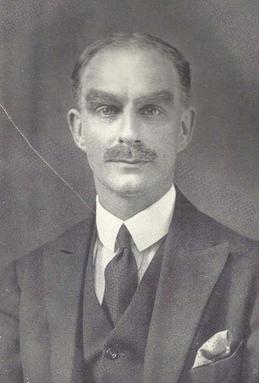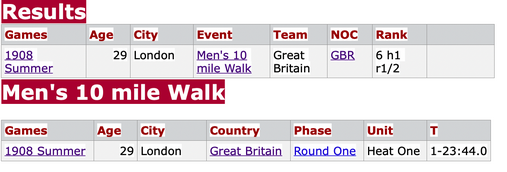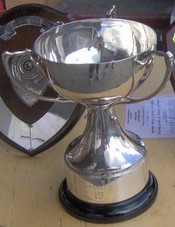C10 Tommy Hammond
Centurions
Tommy Hammond C10
Full name: Thomas Edgar "Tommy" Hammond
Born: June 18, 1878 in Hitcham, Suffolk, Great Britain
Died: December 18, 1945 (Aged 67) in Haywards Heath, West Sussex, Great Britain
Surrey Walking Club (GBR)

Thomas Hammond was an ultra-long distance specialist who first won the London-to-Brighton walk in 1904. In September 1908 he set many British records for time and distance during a successful attempt on the 24-hour record with 131 miles, 580 yards, which was not bettered until five years after his death, in 1950, and it would be another ten years before his time was beaten by another British walker.
His time at 100 miles was 18-04:10.2.
Eight weeks earlier he took part in the 10 mile walk at the Olympics, but for Hammond, this was no more than a sprint and he was eliminated in the heats.
Among the records he set on the road were :
- London-to-Oxford (1907)
- London-to-Brighton and back (1907)
- London-to-Brighton (1908)
- Norwich-to-Ipswich (1914)
T. E. (Tommy) Hammond “World's Best”
Thomas Edgar Hammond first came into prominence in the 52 mile Stock Exchange London to Brighton walk on May 1, 1903, when he finished third (9 hr 35 min 7 sec) to E. F. Broad and G. D. Nicholas (but well outside Jack Butler’s record time of 8 hr 43 min 16 sec).
Taking the pastime up in an enthusiastic manner, he improved very quickly and in April 1904, he won the next edition of the London to Brighton in a best on record time of 8 hr 26 min 57 sec, over an hour faster than Broad’s winning time the previous year and 17 minutes ahead of Butler’s record.. Making reasonable allowance for the extra 2 miles, we have 50 miles in something like 8 hr 10 min.
In June 1904, Hammond joined Surrey Walking Club (he subsequently went on to become one of the club mainstays, filling at various times the positions of Secretary and President) and over the next couple of years, he competed in various long walks as well as throwing himself further into the administration of the sport, becoming a member of the Southern Counties Road Walking Association Committee.
On the walking front, he had some fierce battles with the other famous walkers of the period. Soon after the Brighton win, a track 50 mile event was staged and Hammond was beaten into second place by F. B. Thompson in a new record.
However, in June 1905, Jack Butler regained his 50 mile record with an amazing 7 hr 52 min 27 sec. Then on Sept 22, 1906, Butler beat Hammond by over 10 min in the London to Brighton race, finishing in a record time of 8 hr 23 min 57 sec.
Finally, on Good Friday 1907, Hammond gave people a further taste of his quality as a genuine ‘World’s Best”. On this occasion, he walked from London to Oxford, a distance of 54 .75 miles in 8 hr 51 min 14 sec.
Three months later, on 21-22 June 1907, Hammond was back on the roads and once again left the field in his wake in winning the London to Brighton and Return walk. His time for the 104 mile distance was an amazing 18 hr 13 min 37 sec and broke H. W. Horton’s course record by over 2 hours. He covered the 62 1⁄2 miles (over 100 km) to Brighton in 10 hr 30 min 36 sec and passed the 100 mile mark in 17 hr 25 min 22 sec. Second place at the end of the race was over 2 hours behind him. Pundits of the day thought that this record would be unbeatable.
Long distance walking had a high profile in those days and it was not surprising that in the post Olympic euphoria, a 24 Hour Track Walk race was set up by Middlesex Walking Club. This was reminiscent of the great ultra races of the previous century and it provided a perfect opportunity for Hammond to set even more records. The date was the 11th to 12th of September 1908 and the venue was the White City Stadium, Shepherd’s Bush. 42 of the leading long distance walking exponents toed the starting line.

There was heated discussion as to whether a long distance walk should feature at the 1908 London Olympics but the discussion was lost and only two track walks featured – 3500m and 10 miles. Hammond was duly selected to represent Great Britain and Northern Ireland in the 10 mile track walk and thus had the honour of being one of the inaugural Olympic walkers. Unfortunately, being engaged in long distance training at that time, he did not prove fast enough to get into the final although the papers commented that he walked in beautiful style.
The fiercest competition for Hammond was expected to come from Butler who still held the best track 50 mile walk time and the record for the London to Brighton walk. Expectations were realised when Butler went to an early lead which he maintained for the first 10 miles before others caught and passed him. In a huge upset, he was forced to retire at the 24 mile mark just as Hammond was starting to come into his own. Walking splendidly, he took the overall lead just before the 5 hour mark and was never headed from then on. He covered the first 50 miles in 8 hr 36 min 31 sec and his 12 hour distance was an astounding 68 miles 325 yds. Powering on with no signs of slowing, he created a new 100 miles track record of 18 hr 4 min and 10 1⁄2 sec and eventually finished with an incredible 131 miles 580 yards in 24 hours. This remains a distance that few walkers have been able to beat in the nearly 100 years since.
The next year saw Hammond dominate another London to Brighton walk. The date was 1 May 1909 and the occasion was the Surrey Walking Club’s “Dithy Club” race from Westminster Bridge to the Royal Aquarium in Brighton. Hammond had been keen to have one final go at Butler’s record and this proved the occasion. His time of 8 hr 18 min 18 sec for the 52 miles broke the record by over 5 minutes. Brighton residents in their thousands lined the final miles to witness the performance.
But if Hammond thought that he could go out on a high, he was soon to have a rude awakening. On 4 September 1909, only five months after his walk, H. Ross, in his first 50 mile race, won the Polytechnic Harriers London to Brighton race in an even better time of 8 hr 11 min 14 sec. Hammond had lost his record!
It was a time in which every athlete wanted to be a long distance walker and the cream of athletics vied for the honour and notoriety associated with winning such classic events. In this climate of one-upmanship, events tumbled on one after another.
Two weeks after the Polytechnic Harriers event, Blackheath Harriers hosted yet another 24 hour walking race, at the White City Stadium. By now the incessant racing was taking its toll and the retirees included Hammond, Butler and Ross. Tom Payne of North Shields, a member of the Lancashire Walking Club, won with a distance of 127 miles but the general disappointment was paramount – the favourites were nowhere to be seen and the records did not tumble.
This effectively marked the end of Hammond’s walking career. From now on, he turned more to the administration of the sport and, in 1911, he was one of the group who set up the Centurions. This group took on the role of recognizing the feat of those walkers who walked 100 miles within 24 hours. He was retrospectively awarded Centurion membership number 10 for his 1907 record breaking walk from London to Brighton and Return. He became the inaugural secretary/treasurer for the organisation and was club captain for an incredible 36 years from 1911 to 1946.
from the Australian Victoria Race Walking Club newsletter
the Hammond trophy

winners of the Hammond Trophy
In recognition of his service to the Centurions, it was decided to create a Trophy in his honour.
The Hammond Cup (pictured left) was first presented on the 14th August 1948 for the first walker to reach the 100 mile mark in a 100 mile race or greater distance (eg 24 hours)
Over the last decades the criteria for awarding this trophy has changed several times:
- 2000: changed to the First Male Centurion to reach the 100 Mile mark in a 100 miles or greater distance race.
- 2005: changed to the First Male Finisher at the 100 Mile mark in a 100 miles or greater distance race.
- 2006: changed to the First Male – existing Centurion at the 100 Mile mark in a 100 miles or greater distance race.